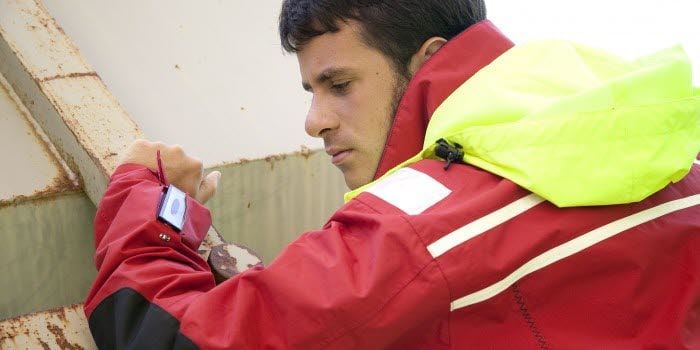Communication is essential during the chaos generated by a fire, earthquake or similar crisis. A standard mobile phone is of only limited help in such circumstances. It is a difficult, if not impossible, task for rescue personnel to operate small mobile phones for reading and sending messages. There has to be a better way.
A common ICT platform
For this reason, ICT researchers at SINTEF have been working for some time on the idea of developing a physical user interface to social media. A year ago they developed a jacket together with students from NTNU. Wires and sensors were installed into the jacket, together with battery-driven circuitry controlling sensors and speakers fitted into one of the pockets. Instead of a phone screen, a display was sewn into the jacket sleeve showing a line of rolling text. A person receiving a message feels a small vibration in his or her collar.
“Making the connection to Facebook was just one example”, says Thomas Vilarinho at SINTEF. “The jacket is now all set to be integrated with a variety of social media platforms”, he says.
When the Norwegian researchers started their involvement in the EU project SOCIETIES, their focus was on finding out how social media and technology could be used to facilitate collaboration between groups. Foreign researchers taking part in the project have been looking into how to promote collaboration among students on campus or among employees in a company. The Norwegians have been researching into how the idea will work for rescue teams in crisis situations. “Our aim has always been to create a platform on which we can integrate all social media services such as LinkedIn, Facebook and Twitter. This has now been completed”, says Vilarinho.
FACTS:
- The jacket is a so-called Arduino unit involving a mobile telephone located in one of the pockets. Arduino is a physical prototyping tool in which physical devices such as screens, speakers and sensors are combined to create a physical interface, such as a jacket.
- The owner of the jacket can activate settings relating to message, audio and vibration using an app installed on a mobile phone, but otherwise the phone remains in one of the pockets. The group leader uses his or her control app to send messages which are then displayed to those wearing the jacket
Communication within a group
Rescue operations are often carried out by large teams of professionals drawn from different organisations. “Our starting point is that these teams must maintain high levels of coordination and communication among themselves while a rescue operation is in progress”, says Vilarinho. “In conversations with Red Cross, police and fire service personnel in Ireland, they have always emphasised how vital it is to keep information within the team in question. They are very careful about what information they distribute outside the team”, he says. For this reason, the researchers have now developed a so-called “peer-to-peer” system and have transferred the service from Facebook to a private, closed, network.
The new Wi-Fi Direct system has been designed for persons in a group operating within the same area, between 20 and 50 metres apart, and in situations where they are not dependant on a mobile network in order to communicate with each other. This is a major advantage because mobile networks are commonly adversely affected during natural disasters and other crisis situations.
The need to respond
A team leader can thus send information from his or her mobile or PC to other members of the team. However, it is still not possible for one jacket to communicate with another. Nor can the receiver of a message respond to the sender.
The researchers have carried out assessments and talked to a variety of users both in Norway and abroad. They have demonstrated the jacket technology to focus groups consisting of 4 to 5 persons in the Irish fire service, and to civil defence personnel in both Ireland and India. The jacket was also demonstrated at the EU’s ICT Event in Vilnius in 2013, during which visitors had a chance to try it out. “Event participants got the chance to play around with the equipment”, says Vilarinho. “And afterwards we discussed issues such as the useful benefits, ease of use and any changes they might suggest.
A major and obvious wish has been to enable team members to acknowledge that a message has been understood, and to send messages back to the leader”, says Vilarinho. The project is headed by TSSG in Waterford in Ireland and will be wound up next month. Norwegian researchers are hoping to be able to continue the work.
- See more at: http://gemini.no/en/2014/04/jacket-works-like-a-mobile-phone/#sthash.dkponVR4.dpuf

